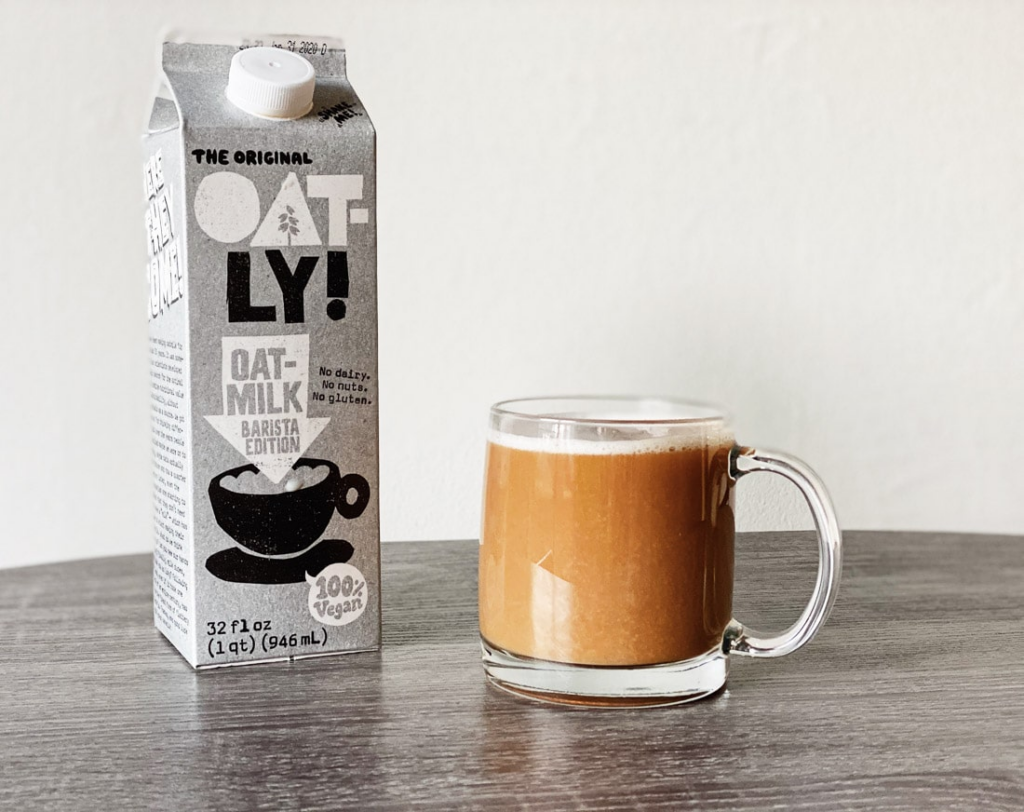Why does Oat Milk Separates in Coffee: A Comprehensive Guide
Why does Oat Milk Separates in Coffee: A Comprehensive Guide
A. The Rising Popularity of Oat Milk in Coffee Culture
In recent years,Why does Oat Milk Separates in Coffee oat milk has emerged as a beloved alternative to traditional dairy and other non-dairy options in the realm of coffee culture. Its popularity has surged among consumers seeking plant-based alternatives that offer a creamy texture and a subtle, naturally sweet flavor profile. With its sustainability credentials, including its relatively low environmental impact compared to dairy farming, oat milk has become a top choice for environmentally-conscious coffee enthusiasts worldwide. As cafes and coffee shops increasingly offer oat milk alongside or even instead of traditional options, its presence in the coffee scene has become ubiquitous.
B. Introduction to the Phenomenon of Oat Milk Separating in Coffee
Despite its popularity, oat milk is not without its quirks, particularly when paired with coffee. One common issue that arises is the separation of oat milk when added to coffee. This separation manifests as the appearance of watery or grainy textures, which can be off-putting to consumers expecting a smooth and creamy consistency in their coffee beverages. This phenomenon has led many to wonder: Why does oat milk separate in coffee?
C. Purpose of the Blog: Delving into the Scientific Reasons Behind This Separation and Offering Solutions
The purpose of this blog is to provide a comprehensive exploration of the science behind why oat milk separates in coffee. By delving into the chemical interactions between oat milk and coffee, including the effects of acidity, temperature, and other factors, we aim to demystify this common occurrence. Furthermore, we will offer practical solutions and tips to help coffee enthusiasts achieve a consistently perfect oat milk coffee experience. Whether you’re a barista looking to troubleshoot oat milk separation in your cafe or a coffee lover seeking to elevate your home brewing game, this blog will equip you with the knowledge and tools to enjoy the perfect oat milk coffee every time.
What Causes Oat Milk to Separate in Coffee?

A. Explanation of the components of oat milk Oat milk is primarily made from oats, water, and sometimes additional ingredients like salt, oil, and sweeteners. The oats are soaked, blended, and strained to create a creamy, dairy-free alternative to cow’s milk. The key components of oat milk relevant to its behavior in coffee include its protein content, carbohydrate composition, and fat content.
B. Interaction between oat milk and coffee When oat milk is added to coffee, several interactions occur between the oat milk’s components and the coffee’s compounds. Oat milk contains soluble fibers and proteins that can bind with coffee particles. However, these interactions are not always stable, leading to separation over time.
C. Role of acidity and temperature in separation Acidity and temperature play significant roles in the separation of oat milk in coffee. Coffee naturally has acidity, which can destabilize the oat milk emulsion. Additionally, temperature fluctuations, such as pouring hot coffee over cold oat milk or vice versa, can cause the oat milk to separate more quickly due to changes in viscosity and protein denaturation.
D. Comparison with other non-dairy milk alternatives Oat milk is not the only non-dairy milk alternative that can separate in coffee. Other plant-based milks like almond milk, soy milk, and coconut milk can also experience separation to varying degrees. However, the specific reasons for separation and the stability of these alternatives in coffee differ based on their composition and processing methods.
Understanding the Science Behind the Separation
A. Emulsion and Homogenization:
Oat milk separation in coffee can be attributed to the breakdown of the emulsion formed when oat milk is mixed with coffee. An emulsion is a mixture of two or more liquids that are normally immiscible, such as oil and water. In this case, oat milk contains both water and fats, which can form an emulsion when combined with coffee. However, without proper homogenization, the fat droplets in the oat milk may not be evenly distributed, leading to separation when mixed with coffee. This lack of homogeneity is a significant factor in why oat milk separates in coffee.
B. Effects of pH Levels:
The pH levels of both oat milk and coffee play a crucial role in the separation process. Oat milk typically has a slightly acidic pH, while coffee can range from acidic to slightly alkaline depending on various factors such as the type of beans and brewing method. When oat milk with its acidic pH comes into contact with coffee, which may also be acidic, it can destabilize the emulsion and cause separation. Understanding the interplay of pH levels is essential in comprehending why oat milk separates in coffee and how to mitigate this effect.
C. Impact of Temperature Changes:
Temperature fluctuations can exacerbate the separation of oat milk in coffee. When hot coffee is poured over cold oat milk or vice versa, the sudden temperature change can destabilize the emulsion and cause the fats in the oat milk to coagulate and separate from the liquid. Additionally, prolonged exposure to heat, such as leaving coffee with oat milk sitting for an extended period, can also lead to separation. Managing temperature is crucial in preventing the undesirable separation of oat milk in coffee.
D. Chemical Reactions Between Oat Milk Proteins and Coffee Compounds:
The chemical composition of oat milk proteins can interact with various compounds present in coffee, contributing to separation. Proteins in oat milk can undergo denaturation or aggregation when exposed to coffee, especially under conditions of high acidity or temperature. These changes in protein structure can destabilize the emulsion and result in the separation of fats from the liquid phase. Understanding the specific chemical reactions occurring between oat milk proteins and coffee compounds sheds light on why oat milk separates in coffee and informs strategies to minimize this occurrence.
Why does Oat Milk Separates in Coffee
By comprehensively examining emulsion formation, pH effects, temperature impacts, and chemical interactions, we can gain valuable insights into why oat milk separates in coffee and implement effective measures to prevent this phenomenon, ensuring a consistently smooth and enjoyable coffee experience.
Solutions to Prevent Separation

A. Preparing oat milk before adding to coffee
- Why does oat milk separate in coffee
- Before adding oat milk to your coffee, ensure it is well-mixed and properly emulsified. Shake the oat milk container thoroughly to redistribute any settled particles and create a more uniform consistency.
- Allow the oat milk to reach room temperature before adding it to hot coffee, as extreme temperature differences can exacerbate separation. This step ensures better integration with the coffee.
B. Adjusting temperature and acidity levels
- Why does oat milk separate in coffee
- Temperature plays a significant role in oat milk separation. Heat can cause the proteins in oat milk to denature, leading to separation in coffee. To prevent this, consider warming the oat milk slightly before adding it to hot coffee, reducing the temperature differential.
- Additionally, acidity levels in coffee can affect oat milk stability. Experiment with different coffee blends or brewing methods to find one with lower acidity, which may help minimize separation.
C. Using alternative brewing methods
- Why does oat milk separate in coffee
- Certain brewing methods, such as espresso or French press, can result in more pronounced oat milk separation due to their intense extraction processes. Consider using alternative methods like pour-over or cold brew, which may produce a smoother and more consistent oat milk coffee experience.
- Cold brew coffee, in particular, tends to have lower acidity and a milder flavor profile, making it less likely to cause oat milk separation.
D. Commercial additives and stabilizers
- Why does oat milk separate in coffee
- Many commercial oat milk brands offer products specifically formulated to resist separation in coffee. Look for oat milk varieties containing stabilizers such as gums or carrageenan, which help maintain emulsion and prevent separation.
- While these additives may not align with everyone’s preferences, they can be an effective solution for achieving a creamy, stable oat milk coffee without separation issues. Be sure to check ingredient labels and choose products that meet your dietary preferences and requirements.
Tips for Achieving the Perfect Oat Milk Coffee

A. Choosing the Right Type of Oat Milk:
- Explanation: Not all oat milk brands are created equal. Some may contain stabilizers or emulsifiers that help prevent separation in coffee better than others.
- How it relates to the focused keyword: By selecting an oat milk brand that addresses the reasons why oat milk separates in coffee, such as those with optimal emulsification properties, you can minimize the likelihood of separation occurring.
B. Experimenting with Different Coffee Brewing Techniques:
- Explanation: Different brewing methods, such as espresso, pour-over, or French press, can produce varying results when combined with oat milk. Experimenting with these methods allows you to find the one that yields the best flavor and texture without separation.
- How it relates to the focused keyword: Understanding how different brewing techniques interact with oat milk can provide insights into why oat milk separates in coffee under certain conditions, helping you mitigate separation issues.
C. Incorporating Flavor Enhancements:
- Explanation: Adding flavor enhancements such as syrups, spices, or sweeteners can complement the taste of oat milk coffee while potentially helping to stabilize the mixture.
- How it relates to the focused keyword: Flavor enhancements can mask any subtle changes in taste or texture caused by oat milk separation, making the coffee-drinking experience more enjoyable despite potential separation issues.
D. Consistency in Storage and Serving:
- Explanation: Properly storing oat milk in the refrigerator and ensuring it is fresh can contribute to its stability when mixed with coffee. Additionally, serving oat milk coffee immediately after preparation can help maintain its consistency.
- How it relates to the focused keyword: Consistency in storage and serving practices can mitigate the factors that contribute to oat milk separation in coffee, such as temperature fluctuations or prolonged exposure to air, thereby reducing the likelihood of separation occurring.
By implementing these tips, coffee enthusiasts can enjoy a delicious and creamy oat milk coffee experience while minimizing the effects of oat milk separation in coffee. Experimentation, careful selection of oat milk brands, and attention to storage and serving practices are key to achieving the perfect oat milk coffee every time.
Conclusion
Recap of the Key Points Discussed: Throughout this blog, we’ve explored the intriguing phenomenon of why oat milk separates in coffee. We’ve dissected the intricate chemistry behind this separation, highlighting factors such as acidity, temperature, and the composition of oat milk itself. Additionally, we’ve discussed practical solutions to prevent separation and achieve the perfect oat milk coffee experience.
Importance of Understanding the Science Behind Oat Milk Separation: Understanding the science behind why oat milk separates in coffee is crucial for coffee enthusiasts and baristas alike. It empowers us to make informed decisions in selecting oat milk brands, adjusting brewing methods, and optimizing the coffee-drinking experience. By grasping the underlying principles, we can troubleshoot separation issues effectively and elevate our enjoyment of oat milk coffee.
Encouragement for Readers to Experiment and Find Their Ideal Oat Milk Coffee Balance: Embracing experimentation is key to mastering the art of oat milk coffee. As you embark on your journey to discover your ideal oat milk coffee balance, don’t be afraid to tweak variables such as temperature, acidity levels, and brewing techniques. Through experimentation, you’ll uncover personalized solutions that cater to your taste preferences and brewing habits.
Call-to-Action for Feedback and Suggestions from Readers: Your feedback is invaluable to us. Whether you have additional insights to share, questions to ask, or suggestions for future topics, we’d love to hear from you. Share your thoughts in the comments below or reach out to us directly. Together, let’s continue unraveling the mysteries of why oat milk separates in coffee and enhance our coffee experiences.
Read more: How Long Do Unroasted Coffee Beans Last?







